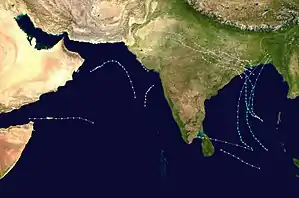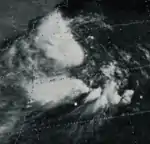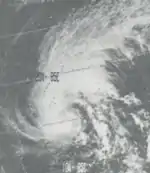1973 North Indian Ocean cyclone season
The 1973 North Indian Ocean cyclone season was part of the annual cycle of tropical cyclone formation. The season has no official bounds but cyclones tend to form between April and December. These dates conventionally delimit the period of each year when most tropical cyclones form in the northern Indian Ocean. There are two main seas in the North Indian Ocean—the Bay of Bengal to the east of the Indian subcontinent and the Arabian Sea to the west of India. The official Regional Specialized Meteorological Centre in this basin is the India Meteorological Department (IMD), while the Joint Typhoon Warning Center (JTWC) releases unofficial advisories. An average of five tropical cyclones form in the North Indian Ocean every season with peaks in May and November.[1] Cyclones occurring between the meridians 45°E and 100°E are included in the season by the IMD.[2]
| 1973 North Indian Ocean cyclone season | |
|---|---|
 Season summary map | |
| Seasonal boundaries | |
| First system formed | Unknown |
| Last system dissipated | Unknown |
| Seasonal statistics | |
| Depressions | 20 |
| Cyclonic storms | 7 |
| Severe cyclonic storms | 4 |
| Total fatalities | Unknown |
| Total damage | Unknown |
| Related articles | |
Systems
May 1973 Arabian cyclone
| Tropical storm (SSHWS) | |
 | |
| Duration | May 27 – May 29 |
|---|---|
| Peak intensity | 65 km/h (40 mph) (1-min) |
This system formed in the Arabian Sea on May 27 and struck the Arabian peninsula on May 28, becoming the tenth system to affect the region since 1891.[3]
June 1973 Arabian cyclone
| Tropical storm (SSHWS) | |
 | |
| Duration | June 6 – June 12 |
|---|---|
| Peak intensity | 65 km/h (40 mph) (1-min) |
October 1973 Bay of Bengal cyclone
| Tropical storm (SSHWS) | |
 | |
| Duration | October 6 – October 12 |
|---|---|
| Peak intensity | 85 km/h (50 mph) (1-min) |
Early November Bay of Bengal cyclone
| Severe cyclonic storm (IMD) | |
| Category 1 tropical cyclone (SSHWS) | |
 | |
| Duration | November 3 – November 9 |
|---|---|
| Peak intensity | 100 km/h (65 mph) (3-min) |
This system was formed on 3 November and intensified upto Severe Cyclonic Storm and Category 1 equivalent Cyclone by 8 November. On 9 November, the storm made landfall at Paradip in Odisha and dissipated rapidly within six hours after the landfall as the storm interacted with a trough. Paradip and Chandbali reported gust winds upto 110 kmph. This cyclone caused considerable agricultural damages to crops there but deaths are unknown.
Mid November Bay of Bengal cyclone
| Tropical storm (SSHWS) | |
 | |
| Duration | November 14 – November 17 |
|---|---|
| Peak intensity | 100 km/h (65 mph) (1-min) |
December 1973 Bay of Bengal cyclone
| Tropical storm (SSHWS) | |
 | |
| Duration | December 5 – December 9 |
|---|---|
| Peak intensity | 110 km/h (70 mph) (1-min) |
This system formed as a tropical depression in the southern Bay on December 5, strengthening into a tropical storm as it turned north-northwest on December 5, then to hurricane strength on December 6. The cyclone recurved, striking Indian near Calcutta on December 9, though its main impacts were across Bangladesh.[4]
See also
- List of North Indian Ocean cyclone seasons
- 1973 Atlantic hurricane season
- 1973 Pacific hurricane season
- 1973 Pacific typhoon season
- Australian cyclone seasons: 1972–73, 1973–74
- South Pacific cyclone seasons: 1972–73, 1973–74
- South-West Indian Ocean cyclone seasons: 1972–73, 1973–74
References
- "Frequently Asked Questions: What is the annual frequency of Cyclones over the Indian Seas? What is its intra-annual variation?". Indian Meteorological Department. 2012. Archived from the original on May 21, 2015. Retrieved June 8, 2012.
- "Bulletins Issued by Regional Specialized Meteorological Centre (RSMC) - Tropical Cyclones, New Delhi" (PDF). India Meteorological Department. May 25, 2009. Archived from the original (PDF) on 2012-04-12. Retrieved July 16, 2012.
- Mariners Weather Log. National Oceanic and Atmospheric Administration. 17 (6): 366. November 1973. Missing or empty
|title=(help) - Richard M. DeAngelis (March 1974). "Hurricane Alley". Mariners Weather Log. 18 (2): 93.